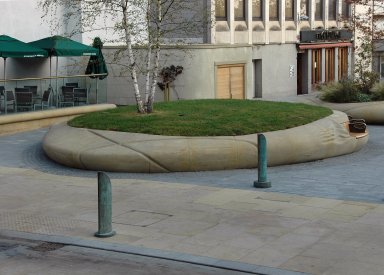Detail View: SHIMMER: Tudor Square

|
Title:
|
Tudor Square
|
|
Creation Date:
|
2010
|
|
Image Date:
|
2010
|
|
Period:
|
20th century ; 21st century
|
|
Location:
|
Sheffield, South Yorkshire
|
|
Country:
|
ENGLAND, UK
|
|
Display Creator:
|
Sheffield City Council
|
|
Image ID:
|
10-1727
|
|
Description:
|
Exterior detail: planters and seating after completion of the 2009-2010 redevelopment of Tudor Square. The space has been completely redesigned with its main thoroughfare down the middle of the square and with seating on the sides. As such it connects the Winter Gardens and the Crucible in a direct line. This increased space can also be given over to media marquees at the time of the World Snooker Championships, which The Crucible hosts every year. The original artworks and landscape design of the 1991 Tudor Square development have been removed when the space was re-designed. The only artworks retained were the paving mosaics by Sue Mason (now Sue DISLEY), which were were re-sited close together near the door to the Crucible Studio, and the Boulsover Monument by Richard PERRY. Commission: Sheffield City Council. Comment: Written on the creation of the original Square as an artwork in 1991. "Tudor Square is a recent invention. It had been an unfocused open space, oddly left between buildings of civic pride and purpose. The space had long been used as a car park. Creation of a square was undertaken when the city took stock of its image prior to the World Student Games in 1991. It was conceived as an arts square. This focus was sensible as the space opened up on all sides to buildings where performances, exhibitions, entertainment took place. The restoration of the Lyceum Theatre was already under consideration. Tudor Square is not a square in the sense of it being an open space of that shape. It is actually a grassed oval which, on a sloping site, creates a flat stage for performances, for displays, for strolling round. The oval is bound by a low stone wall upon which a very intricately placed sequence of marks are carved. Paul Mason, Lead Artist for the project, has said that what was "fundamental to all the practices (in the area) was communication" and that "mark making was fundamental to communication". This became the aesthetic for the square. Marks by which man communicates are found not only on the wall, but form the basis of the design for the tree grilles and railings also in the square. Into the pavement Sue Mason has also set a number of fluid marks. These mosaics were to help orientation in the square. At the Graves Gallery end, a bronze memorial to Thomas Boulsover was placed. Lastly, though invisible from the square, a stairwell of stained glass was commissioned for the Lyceum. "A plaque on the Central Library building in the square directs attention to Tudor Square's distinctiveness. 'The stone wall, mosaics, railings and tree grilles celebrate early signs and symbols of communication amongst people. From such marks all cultures developed different alphabets and languages.' " Text taken from 'Going Public' by Dr Elizabeth Norman, 1995.
|
|
Rights:
|
© Sheffield Hallam University
|
|
Permissions:
|
For educational use only. This image may be used in print or digital materials provided that full acknowledgment is given, expressed as follows: " © < insert details from the 'Rights' field >. Photographed by < insert details from the 'Photographed by' field >."
|
|
Photographed by:
|
Dave Ball
|
|
Creator:
|
Sheffield City Council
|
|
Creator Role:
|
Architects Division, Department of Design and Building Services.
|
|
Subject Heading:
|
Seating (Furniture) -- 2000-2100
|
|
Subject Heading:
|
City squares -- England -- Sheffield
|
|
Subject Heading:
|
Public art -- England -- Sheffield
|
|
Subject Heading:
|
Planting design
|
|
Subject Heading:
|
Landscape design -- England -- Sheffield
|